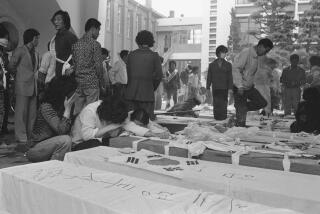Army War Documents Made Public : Vietnam Journals Chronicle Heavy Toll
- Share via
SUITLAND, Md. — The Vietnam War’s messengers of death are inescapable at the National Archives.
The daily journals, the annual history of the Da Nang mortuary, the certificates of death, the records of things left behind--a peace medal, a Bible, tape cassettes--are abundant in the 12 million pages of Army documents recently made public.
Together, they chronicle the heavy toll paid by the 58,156 men and women who died in Vietnam.
The Da Nang mortuary report tells of processing the remains of 5,377 Americans in 1969 and notes that the number of casualties was generally higher in March through May of each year because of regular North Vietnamese and Viet Cong offensives.
Dreaded Knock
The second entry in the daily staff journal of the 74th Medical Battalion at Chu Lai on June 8, 1969, brought the dreaded knock on the door back home in Canton, Ohio, for Kay and John Lane.
“1. 0001 Journal opened.
“2. 0550 Rocket attack 312th area. Resulted in the death of a nurse.
“3. 0720 SFC Bailey called SP5 Ellafrits, 312th Evac, on the casualty report on the death of 1LT Sharon A. Lane, N2337551, 283-38-3327, 312th Evac, as a result of attack at 0550 hrs . . . “
While it was morning in Vietnam, it was the previous evening in the United States because Saigon time was 11 hours ahead. The Lanes heard sketchy details of the rocket attack on the evening news.
First Woman Killed
“Right after that came a knock on the door and we saw this Army car sitting in the driveway,” Kay Lane, now 64, recalled. “When he (the Army officer) came to the door, even before my husband got there, I said, ‘Is she dead?’ He said, ‘Yes.’ ”
A piece of steel from a rocket that landed between Ward 4A and Ward 4B of the 312th Evacuation Hospital had ripped through Sharon Lane’s aorta. She bled to death less than a month before her 26th birthday, the first woman killed by hostile fire in Vietnam.
Among her last letters home, she wrote on June 4, 1969, that her unit had just reached a milestone by treating its 10,000th patient since arriving in Vietnam the previous September. Then she added: “Start ‘nights’ tomorrow, so don’t have to get up early tomorrow. Nice thought. Still very quiet around here. Haven’t gotten mortared for a couple of weeks now. . . .”
Four days later she was dead.
More to Read
Sign up for Essential California
The most important California stories and recommendations in your inbox every morning.
You may occasionally receive promotional content from the Los Angeles Times.












